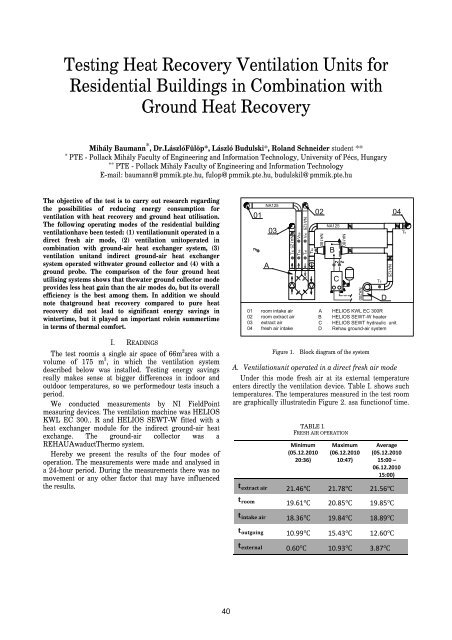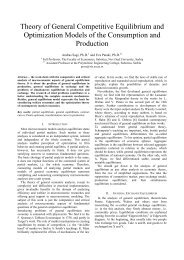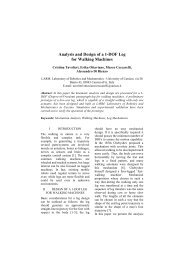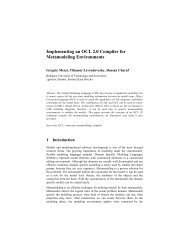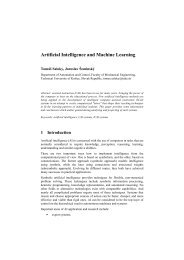Final Program EXPRES 2012 - Conferences
Final Program EXPRES 2012 - Conferences
Final Program EXPRES 2012 - Conferences
- No tags were found...
Create successful ePaper yourself
Turn your PDF publications into a flip-book with our unique Google optimized e-Paper software.
Testing Heat Recovery Ventilation Units forResidential Buildings in Combination withGround Heat RecoveryMihály Baumann * , Dr.LászlóFülöp*, László Budulski*, Roland Schneider student ***PTE - Pollack Mihály Faculty of Engineering and Information Technology, University of Pécs, Hungary**PTE - Pollack Mihály Faculty of Engineering and Information TechnologyE-mail: baumann@pmmik.pte.hu, fulop@pmmik.pte.hu, budulskil@pmmik.pte.huThe objective of the test is to carry out research regardingthe possibilities of reducing energy consumption forventilation with heat recovery and ground heat utilisation.The following operating modes of the residential buildingventilationhave been tested: (1) ventilationunit operated in adirect fresh air mode, (2) ventilation unitoperated incombination with ground-air heat exchanger system, (3)ventilation unitand indirect ground-air heat exchangersystem operated withwater ground collector and (4) with aground probe. The comparison of the four ground heatutilising systems shows that thewater ground collector modeprovides less heat gain than the air modes do, but its overallefficiency is the best among them. In addition we shouldnote thatground heat recovery compared to pure heatrecovery did not lead to significant energy savings inwintertime, but it played an important rolein summertimein terms of thermal comfort.01ThNA125A03NA125Tki01 room intake air02 room extract air03 extract air04 fresh air intakeVbeTbeNA125Tel VelTku0204NA180NA125BTv TeCNA180NA200TtlDNA125A HELIOS KWL EC 300RB HELIOS SEWT-W heaterC HELIOS SEWT hydraulic unitD Rehau ground-air systemTkI. READINGSThe test roomis a single air space of 66m 2 area with avolume of 175 m 3 , in which the ventilation systemdescribed below was installed. Testing energy savingsreally makes sense at bigger differences in indoor andoutdoor temperatures, so we performedour tests insuch aperiod.We conducted measurements by NI FieldPointmeasuring devices. The ventilation machine was HELIOSKWL EC 300.. R and HELIOS SEWT-W fitted with aheat exchanger module for the indirect ground-air heatexchange. The ground-air collector was aREHAUAwaductThermo system.Hereby we present the results of the four modes ofoperation. The measurements were made and analysed ina 24-hour period. During the measurements there was nomovement or any other factor that may have influencedthe results.Figure 1. Block diagram of the systemA. Ventilationunit operated in a direct fresh air modeUnder this mode fresh air at its external temperatureenters directly the ventilation device. Table I. shows suchtemperatures. The temperatures measured in the test roomare graphically illustratedin Figure 2. asa functionof time.TABLE I.FRESH AIR OPERATIONMinimum(05.12.201020:36)Maximum(06.12.201010:47)Average(05.12.201015:00 –06.12.201015:00) 21.46℃ 21.78℃ 21.56℃ 19.61℃ 20.85℃ 19.85℃ 18.36℃ 19.84℃ 18.89℃ 10.99℃ 15.43℃ 12.60℃ 0.60℃ 10.93℃ 3.87℃40


